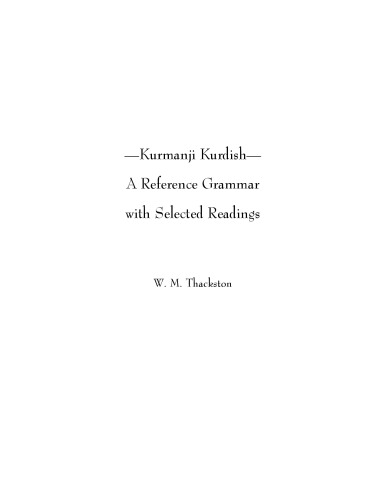

Most ebook files are in PDF format, so you can easily read them using various software such as Foxit Reader or directly on the Google Chrome browser.
Some ebook files are released by publishers in other formats such as .awz, .mobi, .epub, .fb2, etc. You may need to install specific software to read these formats on mobile/PC, such as Calibre.
Please read the tutorial at this link: https://ebookbell.com/faq
We offer FREE conversion to the popular formats you request; however, this may take some time. Therefore, right after payment, please email us, and we will try to provide the service as quickly as possible.
For some exceptional file formats or broken links (if any), please refrain from opening any disputes. Instead, email us first, and we will try to assist within a maximum of 6 hours.
EbookBell Team

4.7
56 reviews
ISBN 13: 9789004700567
Author: Atakan Ince
Aygen, Gülşat, Kurmanjî Kurdish. Languages of the World/Materials 468, München: Lincom Europa, 2007, 92 pp., (ISBN: 9783895860706), (paper).
The literature on the Kurdish language includes instructional textbooks in various languages and several articles on the classification of Kurdish languages. However, there are very few resources to be used as a reference for grammar or descriptive grammar of Kurdish written in English. The book Kurmanjî Kurdish by Güls at Aygen is a concise descriptive grammar of Kurmanjî, a northern dialect of the Kurdish language, which belongs to the Northwest group of Iranian languages of the Indo-European languages (see, MacKenzie, 1961 for a different classification of Iranian languages). This dialect is spoken by the Kurds of Turkey, Eastern Syria, the Caucasus, and in parts of Iran. It makes use of material on Kurmanjî published in languages other than English, as well as presenting data the author elicited from native speakers. It is important to note that grammar books or teaching material produced on Kurmanjî Kurdish are attempts to provide a prescriptive grammar of this language which has never been a standard language of any nation state in history. Written by non-linguists in languages other than English, they could not serve the purpose of introducing Kurmanjî to an audience of English speaking linguists. Aygen’s book has a different aim: it is not a prescriptive but a descriptive grammar written for an audience of linguists.
A linguistic study of any given language is expected to include the major components of grammar, namely: phonology, morphology, syntax and semantics. The phonological component refers to the individual sounds as well as the sound systems; the morphological component refers to the form and meaning correspondences in that language; syntax refers to the word order properties and sentence structure; and finally semantics refers to meaning both at the sentence level and also within discourse. Kurmanjî Kurdish is structured to include all these components expected in any good descriptive grammar, and it is divided into five chapters: introductory remarks, phonology, morphology, syntax, sample texts, and a dialogue to exemplify the grammatical features given in previous chapters. The introductory remarks give a list of the areas where Kurmanjî as well as other dialects of Kurdish are spoken in Turkey, Iran, Iraq and Syria.
The chapter on phonology outlines the articulatory features of vowels and consonants, common phonological processes such as metathesis, vowel and consonant deletion and gemination, syllable structure and stress pattern of Kurmanjî. Although the major reference of this chapter is Bedir Xan and Lescot (2005), Aygen also gives the IPA symbols of the sounds in Kurmanjî. In a brief overview, this chapter is quite informative and gives a general picture of the sound system of Kurmanjî. Kurmanjî has 8 vowels (3 short, 5 long vowels) and 23 consonants. The unique property of this chapter is that it lists region-specific phonological processes as well as general phonological processes. For instance, in Eruh and Serhed regions, /b/ may alternate with /v/ in word-initial and word-final positions: bi – vi “by, with”, cewab – cewav “answer” (ex. 9, p. 6). For phoneticians and phonologists, as well as dialectologists, such detailed information is significant.
The chapter on morphology, being the central chapter, discusses nominal morphology including (in)definiteness/referentiality, number, and gender. It also gives a detailed description of the case system of Kurmanjî: the absolute and oblique cases and the ergative system in Kurmanjî. It continues with a description of possessive structures (the izafe construction), the pronominal system (personal and interrogative pronouns, reflexives and reciprocals, and diminutives), the numeral system, derivation of comparative and superlative forms of adjectives. It also describes temporal adverbs. As to verbal morphology, the chapter discusses complex verbs, passives and causatives, verbal agreement, the Tense/Aspect/Modality system, negation, among others, in Kurmanjî. The indefinite morpheme in Kurmanjî occurs either as a suffix (-ek), derived from yek “one”: mizgef-tek “a mosque”, sêv-ek “an apple” (ex. 32, p. 14). Moreover, although Kurmanjî has a plural marker for nouns (-en), this morpheme cannot occur on nouns in their absolute form. In such cases, agreement marker on the predicate shows whether the noun is plural: xanî hat “the police (officer) came”, xanî hatin “the police officers came” (ex. 34, p. 15). Being a split ergative language, Kurmanjî has absolutive/nominative, oblique and ergative cases.
Turkey, the Kurds, and the Legal Contours of the Right to Self-Determination
Science-Based Truth as News: Knowledge Production and Media in Iraqi Kurdistan
Women’s Activism in Iraqi Kurdistan: Achievements, Shortcomings and Obstacles
Mobilised Diasporas: Kurdish and Berber Movements in Comparative Perspective
Book Reviews
Iraqi Kurds and Nation-Building
The Kurds of Iraq: Building a State within a State
The Kurdish National Movement in Turkey, from Protest to Resistance
Kurmanjî Kurdish
Contesting Kurdish Identities in Sweden: Quest for Belonging among Middle Eastern Youth
kurdish kurmanji words
kurmanji verbs
kurmanji vocabulary
translate kurmanji
kurmanji vs sorani
is kurd a word
Tags: Atakan İnce, Kurdish, Reference, Kurdish, Reference